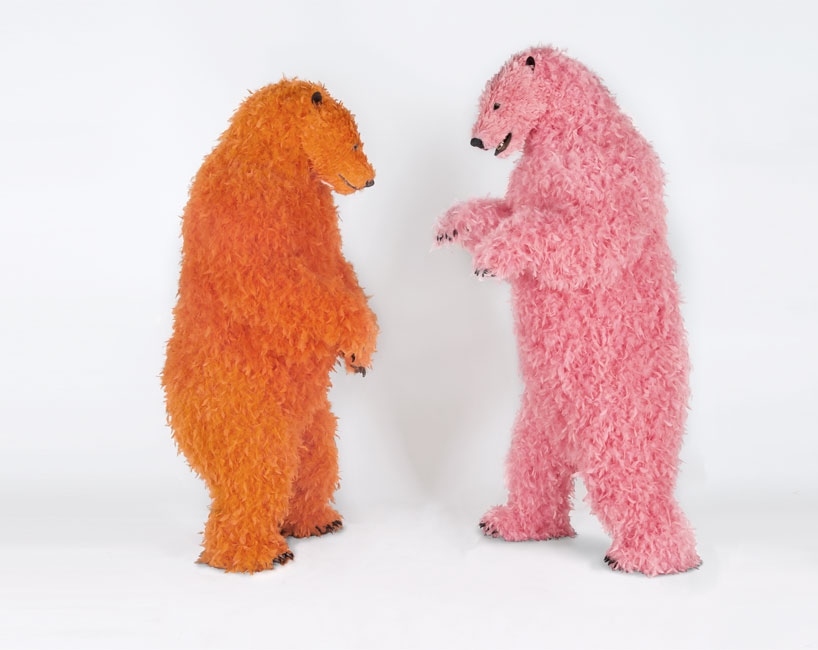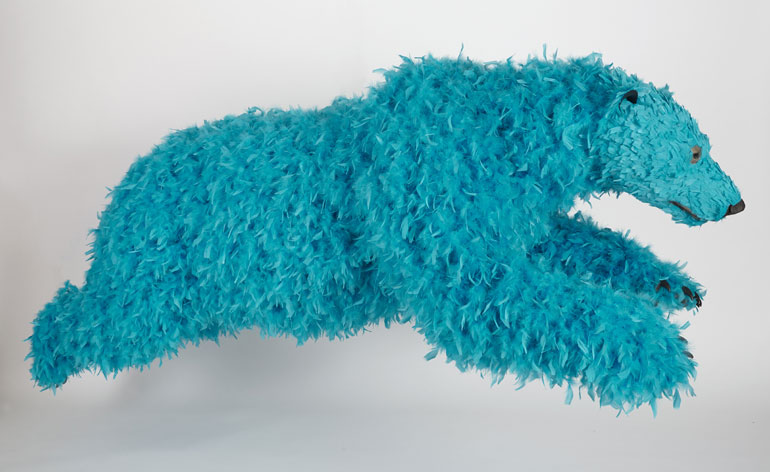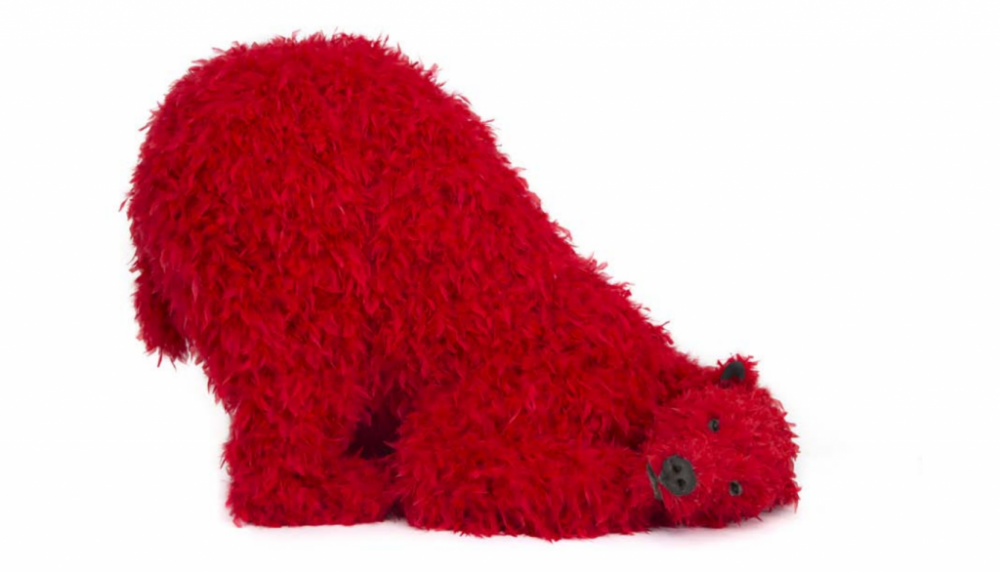Portrait by Neil Rasmus
Andrea Blanch: How long were you living in Alaska and how long did that happen? Why did you decide to go to Alaska?
Poala Pivi: I was living in Alaska from 2006 until 2012. In 2005 I was bored, so I went on a holiday to Alaska. I wanted to get away from my life and my profession, so I pretended to be a journalist and I covered the Iditarod Trail Sled Dog Race.
Did anyone check your credentials?
Art Forum gave me a press pass. So when people questioned me I said I worked for Art Forum. People were puzzled because I was pretty ignorant about the mushing sport, but I was the most dedicated journalist anyone had ever seen in their life. I had the time of my life.
How long were you there?
In 2005 I was there for the race, six weeks. Then I went back one year later and decided to move there.
 Paola Pivi, I never danced before, 2013 & Sometimes I have to stand for my safety, 2013. Photograph by Guillaume Ziccarelli, Courtesy Galerie Perrotin
Paola Pivi, I never danced before, 2013 & Sometimes I have to stand for my safety, 2013. Photograph by Guillaume Ziccarelli, Courtesy Galerie Perrotin
What is more important, the fact that the event happened or the fact that it is documented? Do you feel like an event gains something by being temporary?
The most important thing is that they existed for that time that they existed, whether it was for one month or forever. Then if I want to communicate with people, I need to make something else, like a photo or a video, and so far, photos are the most effective way to talk about it in an artistic way. I only show photos that I believe are art in their own way, like performances. Some performances need audiences, some do not. For example, when I put Zebras on the tops of mountains, there was no audience. I did not feel the need and I did not think about it and I did not want it. When I did the Leopards with the cappuccino cups, I wanted to have an audience because there was a cage, so it was possible to have an audience. The cage was built but the leopard was very scared. He was huge and uncooperative and scared, so the policeman on location immediately denied permission to show the performance to the public. The director was relieved about that decision because it was terrifying to see this huge leopard run around in a gallery space filled with cappuccino cups. When it ran, the cups rattled and shattered, which is a noise we associate with stressful moments. It sounded like a mother or father fighting. The whole performance was terrifying.
Did you enjoy taking the photographs as a journalist at the race?
I’m not a photographer but sometimes I take quality shots. It’s more luck. I’m not a photographer. Taking photographs is a very exhausting and a very tedious process for me.
Why do you think?
When you take a photo you are not entirely present in the moment. It is very, very hard work. Being a journalist was extremely interesting. I took it seriously, so it was a lot of work. I researched extensively on the champions and the dogs, it was a lot of preparation. Also, I’m from Italy, and in Italy journalists are loved. When you say Italian journalist, doors open because everyone wants to hear from the press. In Alaska, when you say you are a journalist, doors close. They couldn’t care less. They were very friendly to me because I was a young woman in an awkward situation but they were also very cold to me because I was a journalist. It was very hard work and half way through the race I gave up and started telling people that I was an artist. It made life easier, people were much more open to me. I am very interested now in journalism from the point of view of revealing hard truths. Journalists do it on behalf of other people. I find this fascinating.
 Paola Pivi, Who told you white men can jump?, 2013, Photograph by Guillaume Ziccarelli Courtesy Galerie Perrotin
Paola Pivi, Who told you white men can jump?, 2013, Photograph by Guillaume Ziccarelli Courtesy Galerie Perrotin
What was the idea behind the fish on the plane? What did that idea represent and what did it mean to you?
The most beautiful part was when we were flying in the sky. The sun above the clouds was very bright and the people on the plane were only there out of strict necessity; the pilot, the flight attendants, the photographer, the photographer’s assistant, the two fish handlers for the animals and me. When we did the take off and landing, we sat in one chair and we put the fish that were in that chair, either under your feet or in the back. We had to count exactly how many people were going to be on the flight. When we walked up the aisle it was incredible because there was this light, and water, only the noise of the plane, and the fish swimming. It did not translate into the photos or videos.
How many fish were there?
84.
The Chinese people: why did you attempt to create genderless identical people for observation?
That piece came when I was living in Shanghai in 1998. I had this flash and noticed that when two Chinese people were dressed in the same way in the street because they worked in the same shop or they went to the same school, somehow the design of the facial feature was highlighted. Maybe because they have such similar hair, when they dress the same the only thing that is different is their face. In those years I thought the Chinese people had very strong individuality or very strong personalities. So then I had this idea to repeat this 100 times. 100 of them in black clothes without connotation. Then I did the performance and we explored so many other meanings and I started on drawing of the faces and then it exploded into millions of things.
How did you get into art?
My family was full of engineers. The only one interested in art was my grandfather, and he only had posters of good paintings in the house. That was the only connection with art I had. I went through life, until I was very old, without every experiencing art. I got into it while I was studying engineering. I was so bored that I would copy drawings, and then some other friend introduced me to a very famous Italian artist, Andrea Bacilli.
 Paola Pivi, ?, 2013, Photograph by Guillaume Ziccarelli. Courtesy Galerie Perrotin
Paola Pivi, ?, 2013, Photograph by Guillaume Ziccarelli. Courtesy Galerie Perrotin
How important is it for you that your work be interactive with a human element or audience?
When there’s an audience that is the best! Performance art is the most extraordinary form of art because it is made and perceived at the same time so it is like live music but it is visual art. It is the purest art form. Also, when it is finished, it is done.
Do you think your work is controversial?
No, though it excites me that people think it is. It is very hard for people to digest my work, it is alien for some people. Generally, I notice that people who like my work are people who enjoy their lives or dreams. They are people who are similar to me, people who are fearless.
Do you have a fantasy that you want to realize but can’t?
Of course? Many! Every artist does.
This is the fantasy issue, I am wondering if you have a personal fantasy at the moment?
At the moment I wish I could get on an airplane with my son and my husband and visit Alaska.


